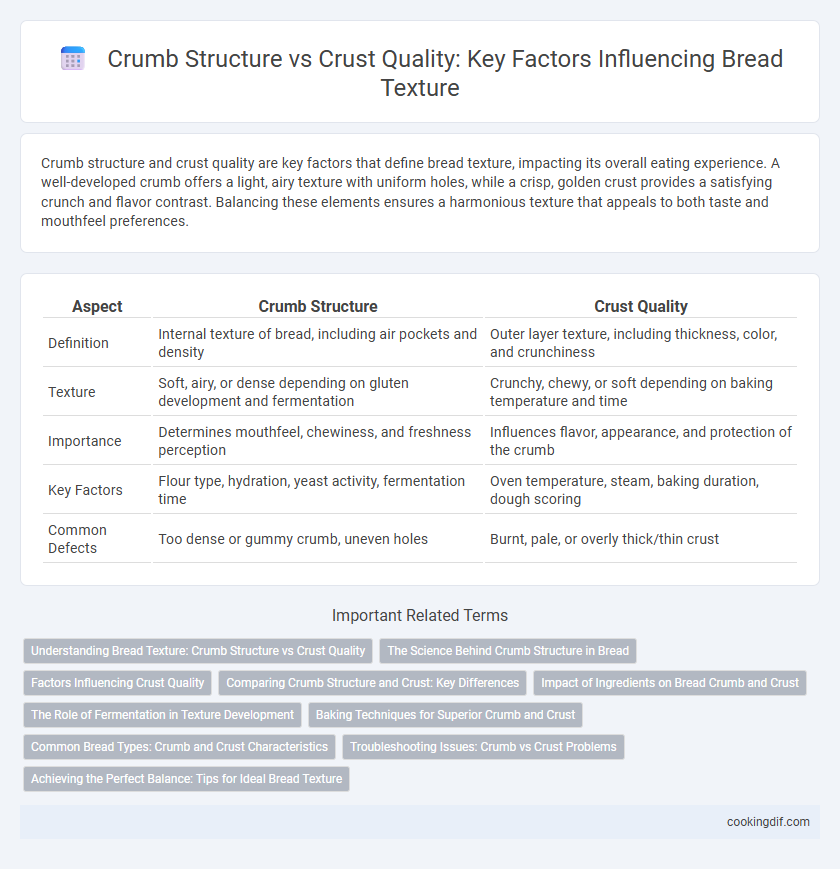Crumb structure and crust quality are key factors that define bread texture, impacting its overall eating experience. A well-developed crumb offers a light, airy texture with uniform holes, while a crisp, golden crust provides a satisfying crunch and flavor contrast. Balancing these elements ensures a harmonious texture that appeals to both taste and mouthfeel preferences.
Table of Comparison
| Aspect | Crumb Structure | Crust Quality |
|---|---|---|
| Definition | Internal texture of bread, including air pockets and density | Outer layer texture, including thickness, color, and crunchiness |
| Texture | Soft, airy, or dense depending on gluten development and fermentation | Crunchy, chewy, or soft depending on baking temperature and time |
| Importance | Determines mouthfeel, chewiness, and freshness perception | Influences flavor, appearance, and protection of the crumb |
| Key Factors | Flour type, hydration, yeast activity, fermentation time | Oven temperature, steam, baking duration, dough scoring |
| Common Defects | Too dense or gummy crumb, uneven holes | Burnt, pale, or overly thick/thin crust |
Understanding Bread Texture: Crumb Structure vs Crust Quality
Crumb structure in bread determines its softness, moisture retention, and overall chewiness, driven by factors such as yeast fermentation and dough hydration levels. Crust quality, characterized by thickness, color, and crispness, results from Maillard reactions and baking temperature, affecting flavor intensity and mouthfeel. Balancing crumb structure and crust quality is essential for achieving a harmonious bread texture that satisfies both sensory appeal and freshness.
The Science Behind Crumb Structure in Bread
Crumb structure in bread is determined by the size, distribution, and uniformity of air pockets formed during fermentation and baking, directly affecting texture and mouthfeel. The protein content, gluten development, and yeast activity influence gas retention, shaping a light or dense crumb. Crust quality, characterized by Maillard reaction and caramelization, provides contrasting crispness, working in tandem with crumb structure to enhance overall sensory experience.
Factors Influencing Crust Quality
Crust quality in bread is primarily influenced by baking temperature, humidity levels, and oven type, which collectively impact Maillard reaction intensity and caramelization, enhancing color and crispness. Dough hydration and sugar content directly affect crust thickness and texture by modifying moisture retention and browning rates. Oven steam injection is crucial for achieving a desirable crust by promoting a glossy, crackly surface while allowing optimal crumb expansion.
Comparing Crumb Structure and Crust: Key Differences
The crumb structure of bread determines its internal texture, characterized by air pockets, moisture, and softness, influencing chewiness and mouthfeel. In contrast, the crust quality refers to the outer layer's thickness, crispness, and color, impacting flavor through caramelization and Maillard reactions. Comparing crumb and crust reveals how their balance affects overall bread satisfaction, with an ideal loaf achieving a tender crumb and a well-developed, flavorful crust.
Impact of Ingredients on Bread Crumb and Crust
The crumb structure and crust quality of bread are significantly influenced by the type and ratio of ingredients such as flour, water, yeast, and fats. High protein flours enhance gluten development, resulting in a chewier crumb and a sturdier crust, while sugar and fats contribute to crust caramelization and tenderness. Enzymes and dough conditioners can further modify crumb softness and crust color, optimizing overall bread texture.
The Role of Fermentation in Texture Development
Fermentation significantly influences crumb structure by promoting gas production that creates an open, airy texture while also impacting crust quality through the development of organic acids and sugars that enhance browning and flavor. Yeast activity during fermentation modulates gluten development, resulting in an elastic crumb that traps carbon dioxide effectively, balancing softness and chewiness. The duration and temperature of fermentation determine the extent of starch breakdown and Maillard reactions, directly affecting crust crispness and color intensity.
Baking Techniques for Superior Crumb and Crust
Mastering baking techniques like proper fermentation and accurate oven temperature control enhances crumb structure by promoting uniform air pockets and moisture retention. Techniques such as steam injection during the initial baking phase optimize crust quality by creating a glossy, crisp exterior while preserving interior softness. Balancing bake time and heat intensity is crucial to achieving an ideal contrast between the tender crumb and the flavorful, well-developed crust.
Common Bread Types: Crumb and Crust Characteristics
In common bread types like sourdough, baguettes, and sandwich loaves, crumb structure varies from open and airy to dense and uniform, directly influencing texture and mouthfeel. Sourdough features a chewy crust with an irregular, open crumb, while baguettes offer a crisp, thin crust paired with a light, porous crumb. Sandwich bread typically has a soft, tender crust and a fine, even crumb designed for softness and uniformity in slices.
Troubleshooting Issues: Crumb vs Crust Problems
Uneven crumb structure in bread often indicates issues with improper fermentation or insufficient kneading, leading to dense, gummy interiors. Crust problems such as excessive hardness or blistering typically stem from oven temperature fluctuations or inadequate steam during baking. Troubleshooting requires adjusting fermentation times and hydration levels for crumb balance while controlling baking environment to achieve optimal crust quality.
Achieving the Perfect Balance: Tips for Ideal Bread Texture
Achieving the perfect bread texture requires balancing a tender crumb structure with a crisp, well-baked crust. Controlling hydration levels and fermentation time can enhance crumb softness without compromising crust crunchiness. Using steam during baking promotes oven spring, resulting in a crust that is both flavorful and texturally complementary to the airy interior.
Crumb Structure vs Crust Quality for bread texture Infographic

 cookingdif.com
cookingdif.com